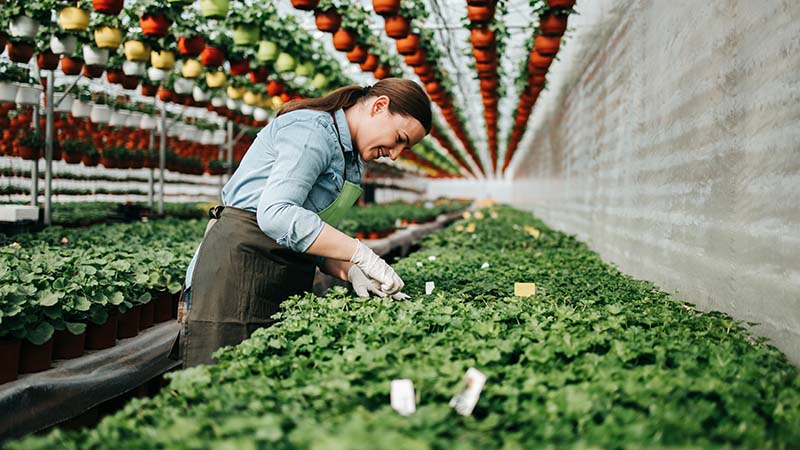The Four Concentric Circles of Controlled-Environment Agriculture

Sonia Lo
Read her LinkedIn bio, and you’ll quickly see that Sonia Lo is not your traditional CEO. A farmer, a chef, an angel investor, and a mother of two who speaks seven languages and holds a third-degree black-belt in Tae-Kwon Do, Sonia Lo is the only woman to serve as CEO of a major vertical farming company (Unfold). She also acts as an executive board member at urban-gro, an integrated professional services and design-build firm focused on the CEA market. She brings decades of combined agriculture, technology, and business experience to the board of directors.
Greenhouse Grower Senior Editor Brian Sparks recently caught up with Sonia to learn more about the future of controlled-environment agriculture, including vertical farming.
Brian Sparks: When you look at the vertical farming industry here in the U.S., what are you seeing in terms of the types of growers there are and the potential for the industry?
Sonia Lo: Based on what I’ve seen through sources like Pitchbook, the vast majority of vertical farms being funded today are in either Northern Europe or the U.S. Asia started with vertical farming about 20 years ago, and then they had a wave of bankruptcies due to inefficiencies. It wasn’t until LED’s started to become cheap and efficient that vertical farming as we think of it today, with fully artificially lit stack shelving or vertical planes, was possible commercially.
Having said that, the vast majority of vertical farms are in a strange no man’s land where they are obtaining venture financing for what is a real asset: new technology. But their revenue is farming revenue, it isn’t technology. That’s a disconnect the industry is going to have to work through, whether it’s franchising its technology, selling component technology, or something that would create sales beyond the produce sales. I think the inflection point is maybe a year or two away. The larger farms have economies of scale in terms of automation and the various pieces of infrastructure used in packing that should allow them to be profitable. This profitability is so important is otherwise you’re using an extraordinarily expensive form of venture capital to finance physical infrastructure. At some point, you need to create a return for your venture capitalists.
Sparks: Where do you think the opportunities are in this market?
Sonia Lo: The easiest way that I like to think about it is around urbanization. Let’s say it’s a town, and you have four concentric circles delineated by distance from that town. The first circle is what I call the microfarm: Something that grows at home or in a nursing home, something that’s growing for personal use and perhaps a few friends. I think most of the ones that go into homes are likely to become furniture. People don’t really understand that these products are quite hard to grow and require tending. You may have one super harvest, and then the next one will be three leaves. If that happens, they’re probably going to throw a sweater over it, and it will join the exercise machine in your closet.
The second concentric circle out is 25 to 50 miles, and I think of that as the sort of mini farm and the mini farm that’s 25,000 to 50,000 square feet. The designs are still being tinkered with, but I think these can be a game changer if the energy piece of it and the automation piece of it can be worked out, because it allows you to do is bypass the “I have to pick early because otherwise it won’t travel” problem.
Then I think you get into the 250- to 400-mile radius, which is where most of the current players are. They’re in that radius because they want to be able to be within the USDA definition of local. They want to be within easy trucking distance, but they’re also focused on cheap energy. This is where you start to get real head-on competition between the sort of high-tech greenhouses that are relatively new and vertical farms that are larger scale. I think both of them have their advantages and disadvantages, and it will be a question of who is better capitalized and who has better operational excellence.
I think at 400 miles-plus, you really get into a competition between open field and the huge indoor farms. These growers have enormous efficiencies, and they excel at growing a high-quality crop. I don’t think we’re going to see a shift away from open field production or anything like that, but I do think that there are going to be changes and competitive advantages to indoor growing from new genetics entering the market.
Sparks: When it comes to collecting data and using that data to make informed production decisions, what is the potential for this segment of the industry?
Sonia Lo: I think every vertical farm has been collecting data in some form or another, whether it’s just to monitor your temperature and relative humidity, or the nutrients you’re putting through your fertigation system.
The next step is collecting lots of really tiny data points about leaf shape, color, and crop quality. I think all of that is in the works right now, but you’ve got very siloed information because nobody wants to share it.
I’d like to see a shared platform where everybody feeds in their data, identifies what type of structure you’re growing in, the type of growing you’re doing, and other information that doesn’t give away your secrets. I think it would help improve the flow of capital to the industry because it creates transparency for capital providers. Unfortunately, I think we’re a ways away from that.









